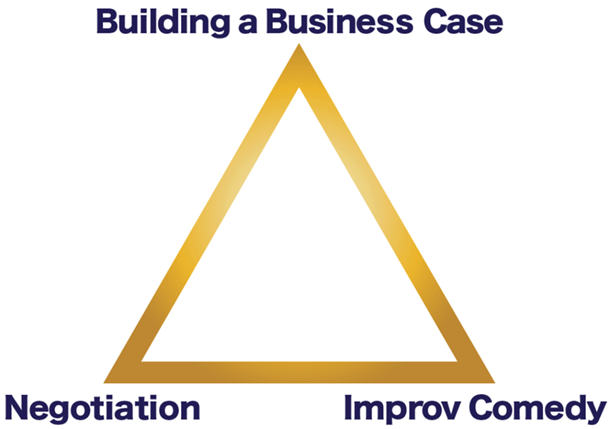By Jack Molisani | Fellow
Learn to pitch your business case, get the resources you need, and negotiate your way to success.
Before writing something for the soft skills issue, I posted the following question on content-related groups on Facebook and LinkedIn: What soft skills do content professionals need to be successful? I received a wide range of answers, so I searched commonalities in the responses and grouped similar answers together. For example, I grouped the following answers under the heading Workplace Negotiation Skills:
- Negotiation
- Diplomacy
- Conflict Resolution
- Finding Common Ground
- Managing Project Scope.
Granted, each of the above is a skill unto itself. But in an effort to find some trends in the data, I did my best to look for the commonalities in the survey answers. There were almost 100 different answers (even with grouping) and here are the top ten (see also Figure 1: Soft Skills for Success).
- Workplace Negotiation Skills
- Listening Skills
- Empathy
- Leadership
- Vision
- Curiosity
- Flexibility
- Patience
- Self-awareness
- Relationship to Management.

While I could easily write an article about each, I think many of the above can be addressed under the headings Workplace Negotiation, Building a Business Case, and Improvisational Comedy (yes, improv comedy!).
Negotiation and Diplomacy Skills
When interviewing for jobs or contracts, I always ask the person I’m meeting to tell me a bit about what they are looking for, as I have learned over the years that the requirements in the job posting often bear little resemblance to the actual job requirements.
Most interviewers answer with something domain- or tool-related. One person, however, replied “Diplomacy skills.” It took all my willpower not to cock my head like the cartoon dog Scooby Doo and say “urrrrr???” Instead I calmly nodded and said, “Tell me more.”
Apparently, the subject matter experts in this company were all brilliant scientists, each of who felt he/she was always right. So they needed a technical writer who not only could manage strong personalities, they needed someone who can manage conflicting edits from strong-willed SMEs. Enter workplace negotiation skills.
What Is Negotating?
For many people, the term negotiating brings to mind unpleasant haggling with a used car salesperson. But negotiating isn’t something you do just when buying a large-ticket item. Deciding what features will be documented given the time available, getting your kids to clean their rooms before playing video games, even deciding what movie to watch on date night all involve negotiating in one form or another. Some common definitions of negotiating include:
- To attempt to come to an agreement on something through discussion and compromise (Dictionary.com)
- The process of achieving agreement through discussion (Wiktionary.com)
- Conferring, discussing, or bargaining to reach agreement (Webster’s Dictionary).
Note that all three definitions include the word agreement.
Next, let’s look at the derivation: Latin negotiatus, past participle of negotiari to “carry on business, do business.” So negotiation is just part and parcel of doing business! Interesting, huh?
For what would you (a staff or contract content professional) be negotiating?
- Your Compensation
- Project Scope
- Project Deadlines
- Resources
- Headcount
- Comp time
- Training
- Authoring Tools, etc.
What do you regularly give up in order to get what you want in the workplace? Most often it is your free time (deadlines!), money, or job security (if there is such a thing anymore). So you could also say that negotiation is the art of giving up as little of what you have in order to get what you want.
In order to justify what you are asking for, it help to build a business case.
Building a Business Case
A business case is a document that explains why your organization should give you what you’re asking for (usually money), usually in terms of ROI. The amount of money that is anticipated to be saved or generated as the direct result of expenditure is known as return on investment (ROI). ROI is normally measured in time and money: how long it will take to recoup the money spent, and how much money will be generated or saved.
For example, energy-efficient LED light bulbs might cost $7 dollars each, but if they use $1.00 less energy a month than traditional incandescent light bulbs, they pay for themselves in seven months. Another example: A client of mine translates their documentation into 26 languages. When their documentation was authored in MS Word, they needed to send the whole document to the translators to update (which can be time consuming and expensive). However, when they started authoring in a component content management system, only the individual topics that have changed need to be translated. My client reported that they recouped the entire cost of purchasing a content management system (through reduced translation costs) in just one product release!
When you build your business case, state:
- The problem
- One or more solutions
- How much it will cost to implement the solution(s)
- How much it will cost the organization if you do nothing
- The ROI that could be realized if a solution is implemented.
State how the situation is a problem for the organization (not just for you), and state the problem in terms of dollars and cents. For example, say you are building a business case to migrate legacy content from MS Word into a content management system. The problem is not “We need a content management system,” the problem is “We are spending more than we need to on translation costs.” Even better if you can use hard numbers: “We are wasting $50,000 a release on translation costs by not having a content management system.”
Here is an example that illustrates why one should include “the cost of doing nothing” in a business case. The United States Postal Service contracted a major US airline to carry airmail. At the time, the postal service had started adding bar codes to the bottom of all letters to better automate the tracking, routing, and delivering of mail. The postal service thought that using these bar codes was so important that if the airline wasn’t able to scan each piece of mail by the roll-out date, the airline still had to carry the mail—they just wouldn’t be paid for it.
The airline in question spent millions buying equipment to scan mail, but they didn’t have any policies and procedures in place on where to put the mail in their hub cites when it wasn’t on a plane. So the airline came to us (a staffing agency) and asked us to find two tech writers in each of their hub cites to document where and how to route the mail for that particular airport. We promptly found the perfect team of writers to do that—until the airline project manager called me to say he couldn’t get the purchase order approved.
“So what are you going to do?” “We’re going to cobble together a team from various internal resources.”
I suspected that using non-technical writers to create detailed policies and procedures was doomed to fail, so I waited two months and then called the project manager. I asked how the project went, and he replied, “It failed miserably. In fact, we lost over $5.5 million in revenue because we weren’t barcode compliant on the roll-out date.”
“Wait a second. Are you trying to tell me that you lost over $5.5 million dollars in revenue because you couldn’t get a $50,000 PO approved??” He replied, “In the current circumstances [the company was in Chapter 7 bankruptcy], it’s easier to explain away lost revenue than to get a purchase order approved.”
Clearly this project manager didn’t do a good enough job of documenting the cost of doing nothing when submitting the business case for that purchase request!
By finding ways to decrease costs, increase profits, and reduce risk, you can add to your organization’s bottom line. Which, in turn, is a business case for getting a raise come review time, right?
So far we’ve covered workplace negotiation and building business cases, but how does improv comedy fit in?
Improv Comedy
Have you ever been asked a question that you weren’t expecting and struggled to find an answer? Or have you ever been in a meeting that wasn’t going well, and wished you could steer the conversation in a different direction?
Improv comedy to the rescue!
Improvised comedy is a performance art where people create skits or scenes based on audience suggestions, much like the U.K. and U.S. television shows, Whose Line Is It Anyway? I’d been watching a local improv group perform for years, and when they invited me to take their Introduction to Improv class, I jumped at the chance. While I expected to have fun (which I did), I didn’t expect to learn lessons that would advance my techcomm career.
Yes, and…
The first law of improv comedy is “Yes, and…”, meaning you accept whatever your partner gives you and add to it. For example, if a partner mimes balancing on a tightrope saying, “Daddy, I’m scared!”, you would accept that premise and add to it, such as pointing to the imaginary water and replying, “Be careful, Billy—those alligators look hungry!” By doing “Yes, and”, you move the story forward, creating an experience that builds one line to the next. It’s fun for you, your partner, and the audience. The opposite of “Yes, and” would be replying with a completely different story line, or worse—flat out contradicting your partner.
Keep this in mind the next time you are in a work meeting. Observe how you react to others’ ideas, and how they react to yours. Get in the habit of “Yes, and”-ing positive suggestions and see if your group gets more done—and has more fun in the process. Similarly, if someone offers what you think is a bad idea, rather than saying, “That’s dumb!”, say “Yes, and we could also try [a terrific idea of your own]!”
Commit!
The next lesson I learned is that no matter what you do, commit to it. If you step forward and offer a line timidly, it will fall flat and drag down the energy of the performance. Even if what you say or do isn’t the funniest or smartest choice, by committing to the action, by really owning the performance and going for it with as much energy and enthusiasm as you can muster—the audience will appreciate you taking a risk, even cheer you on. So, the next time you are interviewing for a job, pitching an idea to management, or speaking at an event, be bold. Seize the opportunity!
Turn Off Your Censor
When I mention to friends that I do improv, many often state that they could never think fast enough to do improv. What’s interesting is that the first thing they teach in improv is to not think, but just be in the moment and listen.
Your mind exists to keep you safe. Performing in front of people (or speaking up in a work meeting) is anything but safe, so your mind wants to sensor what you think, what you do, what you say. And while such censorship is absolutely vital to avoiding hot stoves and speeding cars, it can work against you at work, at networking events, at conferences. If you’re thinking, “Is this right? Will I look stupid?, your attention is in your head, not on the person or people with whom you are speaking.
No matter where you are, just be there—in mind, body, and spirit. Turning off (or at least ignoring) your mental censor may seem difficult if not impossible at first, but it does get easier with practice.
Really Listen
Have you ever had a conversation in which you could tell the other person was thinking about what they are going to say next rather than listening to what you were saying at the moment? If you are actively thinking of the next thing to say, then you are not actively listening. You need to listen to your partner/coworker/castmate to effectively “Yes, and…” in response. By actively listening and using “Yes, and”, you can smoothly respond to questions you weren’t expecting. Want to get more done, make more money, have a calmer life? Be less in your head, listen more.
Be a Gracious Follower
Another life lesson learned from studying improv: be a gracious follower. At the beginning of my first improv class, the instructor laid down only two rules: “Have fun” and “Be supportive.”
When the course began, some students were reluctant to go first and others struggled to find an idea to open with. Being a personality Type-A extrovert, I had no such problems—I always had an idea, and I always wanted to go first. What I had to work on was not confidence, but patience. I had to practice waiting and letting others take the lead.
This is especially important in work situations. How often are the enthusiastic extroverts talking at the expense of more reserved introverts? Quiet introverts have opinions and ideas that are just as valuable as their louder counterparts. However, introverts process information differently—they often need time to digest a question, synthesize their thoughts, and present their ideas later. So now I actively listen to others (in work, in class, in life), and let them lead as well.
The Golden Triangle

You can have the greatest idea for generating revenue or saving your organization money, but it will never happen if the project isn’t heard and funded. By honing your workplace negotiation skills, your ability to “Yes, and…”, and your ability to craft iron-clad business cases, you’ll be able to handle almost any workplace situation, obtain resources, and advance your career.
So pitch your business case, get the resources you need, and negotiate a raise and a promotion. The sky’s the limit!
 Jack Molisani is an STC Fellow and the president of ProSpring Technical Staffing. He also produces the LavaCon Conference on Content Strategy and TechComm Management, and is the author of Be the Captain of Your Career: A New Approach to Career Planning and Advancement.
Jack Molisani is an STC Fellow and the president of ProSpring Technical Staffing. He also produces the LavaCon Conference on Content Strategy and TechComm Management, and is the author of Be the Captain of Your Career: A New Approach to Career Planning and Advancement.
You can reach jack at: Jack@ProspringStaffing.com and connect with him on LinkedIn at https://www.linkedin.com/in/jackmolisani.


